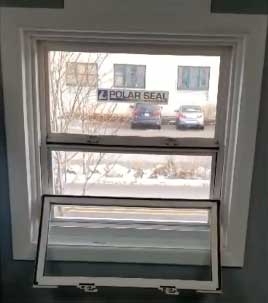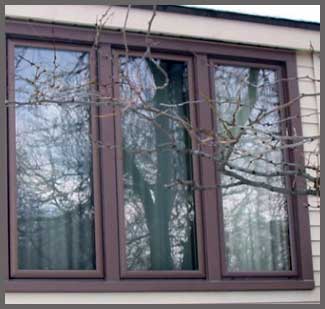Polar Seal windows have become a popular choice for homeowners looking to replace their old, drafty windows with new, energy-efficient models. However, like any product, Polar Seal windows have received their fair share of complaints over the years.
In this article, we’ll take an in-depth look at some of the most common complaints lodged against Polar Seal windows, explore potential causes and solutions for these issues, and provide tips for current or prospective Polar Seal customers.
Polar Seal Windows Issues And Complaints
- Fogging Between Window Panes

One of the most frequently cited complaints against Polar Seal windows is that the space between the dual panes of glass will fog up, obscuring visibility.
This fogging indicates a breach in the window’s insulating seals, allowing moisture to enter and condense on the inner surfaces of the glass.
Fogging is often more prevalent in colder climates, where wide temperature differences exist between indoor and outdoor environments.
Pressure changes from altitude differences can also cause seal failure in the closed space between panes.
Furthermore, defective or poorly installed spacers between the panes can lead to seal failure and eventual fogging.
If you notice fogging between the panes of your Polar Seal windows, the window unit will likely need to be replaced, as the insulating seals cannot be repaired. Polar Seal may cover fogging issues under warranty if they occur within the coverage timeframe, usually 5-20 years.
To prevent further fogging issues, ensure any new window units are installed properly according to manufacturer specifications. Also consider enhanced sealing options like gas fills, which replace air between panes with less conductive gases to reduce temperature transfer and condensation.
- Draftiness from Poor Sealing
Another common complaint is that Polar Seal windows allow cold drafts into the home, defeating their intended purpose as insulating windows. Poor sealing is often to blame for such draftiness.
The window units may not have been properly sealed during installation. Using the wrong types of caulking or sealants, failing to create a continuous seal around the entire window frame, or improper installation of exterior seals like siding or flashing can all allow gaps for air infiltration.
Over time, sealing materials can also shrink or degrade, compromising what was once an airtight barrier. Changing pressure and slight shifting of the home’s foundation can further distort once-tight seals.
To improve draftiness, conduct thorough inspections around each window to locate and re-seal any breaches in the caulking, siding, or flashing. For lasting results, consider re-installation by an experienced contractor.
Also discuss enhanced sealing add-ons like integrated weatherstripping within the window construction itself. Upgrading to higher performance glass options can also help reduce convection and conduction through the panes.
- Excessive Condensation

Polar Seal windows with inferior insulating properties can lead to excessive condensation forming on the window glass.
This occurs when warm, moist interior air contacts the colder glass surface.
Improper installation can also neg negate the window’s insulating benefits and lead to cold surface temperatures.
Excessive condensation left unchecked can lead to mold, mildew, and rot over time. To reduce condensation, FIRST ensure installation according to manufacturer guidelines and building codes, maintaining recommended insulation levels around the window frame.
Also run exhaust fans, especially when showering or cooking, to vent excess interior moisture. Consider installing a whole-house humidifier if your climate suffers from chronic humidity issues. Keep blinds and window coverings open during the day to allow air circulation and light solar heat gain.
- Short Lifespans
Some customers report that Polar Seal windows fail or deteriorate prematurely, sometimes within just a few years of installation.
Subpar vinyl frames may warp, crack, or become brittle quickly, especially with exposure to intense heat, cold, or UV rays. Weak manufacturing of the insulating glass units themselves can also shorten usable lifespans.
Using low-cost vinyl formulations to cut costs is one potential cause of short lifespan issues. Insufficient steel or aluminum reinforcements in the vinyl frame extrusions may lead to sagging or distortions over time. For glass units, poor quality control during the manufacturing process can cause seal failure or cracks within the insulated glass.
To maximize lifespan, choose Polar Seal windows with upgraded vinyl formulations, like welded corners and multi-chambered frame walls. Also select units with reinforced or non-metal components around the glass seal.
Installation according to guidelines and proper protection from elements can further extend the usable life of units.
- High Costs
Polar Seal windows can represent a significant upfront investment, sometimes two to three times the cost of basic single or double pane vinyl window alternatives.
The elevated cost comes from the multi-layer sealed glass units, specialized vinyl or composite frames, and high-performance seals/gaskets. However, cheaper manufacturing options like thin vinyl extrusions or low durability sealants cut costs at the expense of performance, undercutting the intended value.
To maximize return on investment, choose Polar Seal products with robust frames, reinforced corners, high visible light transmittance glass, and added features like argon gas fills or laminated security glass only if needed.
Avoid base models with minimal features or thin vinyl frames, which hamper durability. Consider ordering a few high-performance windows for frequently used rooms rather than lower-tier options for the whole house.
- Difficulty Opening and Closing

Some homeowners report problems with opening and closing Polar Seal windows, as well as issues keeping them locked in position.
Sticking or stiff operation can result from paint, sealant, or construction debris fouling the window tracks during installation.
Insufficient lubrication of tracks and roller systems at the factory can also cause subsequent operation issues.
Over time, vinyl and seal materials may warp or become misaligned from home settling, preventing smooth operation. Excessive exposure to sun and heat can cause vinyl frames or seals to expand and bind window operation.
To improve functionality, thoroughly clean tracks and rollers of any contaminants, then lubricate with approved lubricants per manufacturer instructions. Adjusting rollers or guide blocks may be required if vinyl components have warped over time.
Avoid painting, sealing, or otherwise bonding frames closed. Also ensure sufficient overhang above windows to limit sun exposure on frames.
- Rattling Noises
Some Polar Seal windows are prone to rattling noises, especially in windy conditions. This can occur from loose or poorly secured window panes in the frame. Insufficient foam insulation around the window unit during installation can also lead to movement and noises.
Misaligned locking mechanisms and cloudy or degraded seals can enable enough movement between glass and frame components to generate rattles. Insufficient structural support around heavy windows or large openings also contributes.
If rattling occurs, first ensure at least 1 inch perimeter foam insulation around the frame and robust structural support, like reinforced headers over large units. Inspect for any cracked welds, degraded seals, or loose window pane corners.
Adjust, fortify, or replace failed seals/gaskets and any loose screws, latches, or hardware. Lubricating and realigning locking mechanisms can also help reduce unwanted noises.
- Difficulties with Screen Attachment and Removal
Polar Seal windows typically come with screens that attach to the window frame. However, many users complain that these screens are difficult to attach and remove.
Often, the screen attachment pieces along the window frame edges are small and tricky to line up with the screen frame. Tight tolerances between the screen and window designed to secure the screen also impede easy attachment and removal.
Fixed screens with no removable option at all further limit access to the window.
To facilitate screen use, ensure the window has large, conveniently located screen attachment access points. Seek windows with detachable screens either on the interior or exterior side rather than fixed screens.
Larger tab areas, magnets, or simple hooks along the screen frame’s edges instead of small push pins also make them easier to manipulate. Lubricating tight sliding components on the screen and window can help too.
- Limited Size Options
One of the more common complaints is that Polar Seal limits their window offerings to just a few standard window sizes. This requires customers to settle for whatever sizes the company offers closest to their needs rather than perfectly customized options.
Limited size options constrain homeowners attempting to do full window replacements for rooms with non-standard opening sizes. The inability to order more customized sizes forces customers to go with fewer, larger windows rather than more properly sized units for optimal daylighting and aesthetics.
To satisfy customer needs, Polar Seal could expand size offerings, even at a small upcharge, to allow for more customization freedom. They may also want to allow custom order sizes even if at a premium cost.
Partnering with local glaziers to accommodate complete custom fabrication and retrofit needs is another option to satisfy niche requirements.
Frequently Asked Questions (FAQ)
Many Polar Seal windows meet Energy Star requirements, which focuses on insulating R-values, solar heat gain coefficients, air infiltration rates, condensation resistance, and other performance metrics. Their highest-tier triple pane window options tend to score the best for energy efficiency. However, Energy Star ratings can vary by specific product line, glass technologies, and features, so check certification for the exact windows being considered.
Use a soft, lint-free cloth or sponge with a mild dish detergent and warm water solution to clean the window frames and glass surfaces. Avoid harsh cleaners or abrasive pads. Dry the frames and glass fully after washing. Vinegar or ammonia-based cleaners can be used for more stubborn debris and hard water stains.
Some popular Michigan-based window manufacturers include Great Lakes Window, AMI, Vinyl Window Designs, Crystal Windows, Weather Shield Windows & Doors, and Soft-Lite. Many specialize in vinyl windows but also offer fiberglass and wood window options. Several major national brands like Pella, Andersen, and Jeld-Wen also operate factories within Michigan.
The Bottom Line
Polar Seal windows can offer homeowners increased energy savings, noise reduction, aesthetic upgrades, and reduced exterior maintenance needs compared to ordinary single pane windows. However, as with any window replacement, proper installation according to building codes and manufacturer guidelines is paramount to achieve optimal performance and satisfaction.
Careful window selection based on climate needs, usage requirements, and overall value versus cost considerations is also key. For suitable installations and weather conditions, Polar Seal windows present a compelling option over lower-performing budget window models that carry many of the same installation and manufacturing quality concerns.
With reasonable expectations and proper maintenance, Polar Seal windows can provide homeowners increased comfort and energy efficiency for years to come.

